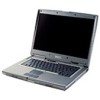Dell Precision M60 Contens: Dell Precision M60 Series Mobile Workstation User' - Page 110
Changing Printer Modes, Changing COM Ports, Enabling the Infrared Sensor
 |
View all Dell Precision M60 manuals
Add to My Manuals
Save this manual to your list of manuals |
Page 110 highlights
l Diskette Drive l Modular bay HDD l Internal HDD l CD/DVD/CD-RW drive During the boot routine, the computer starts at the top of the list and scans each enabled device for the operating system start-up files. When the computer finds the files, it stops searching and starts the operating system. To control the boot devices, select (highlight) a device by pressing the or key, and then enable or disable the device or change its order in the list. l To enable or disable a device, highlight the item and press disabled items appear blue or dimmed without a triangle. . Enabled items appear as white and display a small triangle to the left; l To reorder a device in the list, highlight the device and then press or (not case-sensitive) to move the highlighted device up or down. Boot sequence changes take effect as soon as you save the changes and exit the system setup program. Performing a One-Time Boot You can set a one-time-only boot sequence without entering the system setup program. (You can also use this procedure to boot the Dell Diagnostics on the diagnostics utility partition on your hard drive.) 1. Turn off the computer. 2. If the computer is connected to a docking device (docked), undock it. See the documentation that came with your docking device for instructions. 3. Connect the computer to an electrical outlet. 4. Turn on the computer. When the DELL logo appears, press immediately. If you wait too long and the Windows logo appears, continue to wait until you see the Windows desktop. Then shut down your computer and try again. 5. When the boot device list appears, highlight the device from which you want to boot and press . The computer boots to the selected device. The next time you reboot the computer, the previous boot order is restored. Changing Printer Modes Set the Parallel Mode option according to the type of printer or device connected to the parallel connector. To determine the correct mode to use, see the documentation that came with the device. Setting Parallel Mode to Disabled disables the parallel port and the port's LPT address, freeing computer resources for another device to use. Changing COM Ports Serial Port allows you to map the serial port COM address or disable the serial port and its address, freeing computer resources for another device to use. Enabling the Infrared Sensor 1. Enter the system setup program: a. Turn on your computer. b. Press when the DELL™ logo appears. 2. Press until you locate Infrared Data Port under Basic Device Configuration. NOTE: Ensure that the COM port that you select is different from the COM port assigned to the serial connector. 3. Press the down-arrow key to select the Infrared Data Port setting, and press the right- arrow key to change the setting to a COM port. 4. Press the down-arrow key to select the Infrared Mode setting, and press the right- arrow key to change the setting to Fast IR or Slow IR. It is recommended that you use Fast IR. If the infrared device cannot communicate with your computer, shut down the computer and repeat steps 1 through 5 to change the setting to Slow IR. 5. Press and then click Yes to save the changes and exit the system setup program. If you are prompted to restart your computer, click Yes. 6. Follow the instructions on the screen. 7. After the infrared sensor has been enabled, click Yes to restart the computer.















